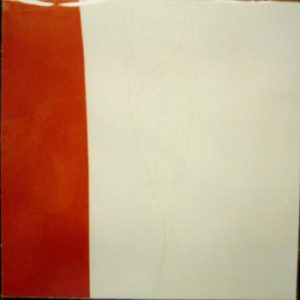calsfoundation@cals.org
Paul E. Maxwell (1925–2015)
Paul E. Maxwell was a modern artist and sculptor who developed a technique for using stencils to create thickly textured and layered surfaces, as well as objects he patented as “stencil casting” but that later became known as “Maxwell Pochoir.” He was also known for creating the “Max Wall” in the West Atrium of the Dallas Apparel Mart; though demolished in 2006, it can be seen as a backdrop in the science-fiction movie Logan’s Run. His work is highly abstract and often consists of some kind of grid—a form that is non-hierarchical and illustrates a major theme of his work.
Paul Maxwell was born in Frost Prairie (Ashley County) on September 17, 1925, to the farm family of Willie F. and Robert M. Maxwell. The sixth of seven children, Maxwell considered himself an artist from an early age and recalled the landscape of Frost Prairie as “pure form—wide unbroken fields of tall grass which the slightest breeze could shape into waves and ripples of golden light.” He said that drawing in the exposed clay soil there may have been an early inspiration for the kind of textured surfaces he would later create.
When Maxwell was nine, the family moved to Bastrop, Louisiana, where he completed high school. Maxwell went on to graduate from Principia College in Elsah, Illinois, in 1950 with a BA in art, followed by graduate work at Claremont College in California. While at Claremont, Maxwell had his first museum show in Stockton, California. In 1951, Maxwell exhibited his work at the Los Angeles County Museum of Art in a show that included such artists as Picasso, Miro, and Matta; also that year, he had his first commercial gallery exhibition.
From 1955 to 1958, Maxwell taught at the Houston Museum of Art and at the University of Houston. From 1959 to 1961, he lectured and exhibited his work in Europe under the sponsorship of the U.S. Information Agency while maintaining a gallery in Switzerland. During the rest of the 1960s and into the 1970s and 1980s, Maxwell lived and worked in Texas and Oklahoma, receiving commissions for works in public spaces such as a wall sculpture in the Will Rogers World Airport in Oklahoma City, Oklahoma, and the free-standing sculpture for the lobby of the Stark County Library in Canton, Ohio.
It was also during the 1970s that Maxwell developed and created pieces using his stencil-casting technique. In 1985, a twelve-minute documentary that dealt with Maxwell’s work was produced by Carol Shroeder and broadcast by PBS. The documentary, titled Paul Maxwell: Lines/Horizons, won the American Film Festival Red Ribbon Award for Best Short Documentary and the Mitchell Wilder Gold Medal Award given by the Texas Association of Museums, both in 1986. Maxwell was also the subject of the 2007 short film Through a Veil of Knowledge: The Legacy of Paul Maxwell, directed by Richard Balin.
Maxwell had exhibitions in galleries and museums throughout the United States and in England, Switzerland, France, Canada, and Australia. The permanent collection at the Arkansas Museum of Fine Arts in Little Rock (Pulaski County) includes the Maxwell piece Regimenta (1980), an acrylic painting on paper.
Maxwell died on July 10, 2015.
For additional information:
The Art of Paul Maxwell. http://www.paulmaxwell.com/ (accessed January 12, 2023).
Kaufman, Charles. “Arkansan Scores Big With Art.” Arkansas Gazette, September 12, 1979, pp. 1B, 8B.
Bill Norman
Little Rock, Arkansas
Staff of the CALS Encyclopedia of Arkansas
 Untitled, by Paul E. Maxwell
Untitled, by Paul E. Maxwell 



Comments
No comments on this entry yet.